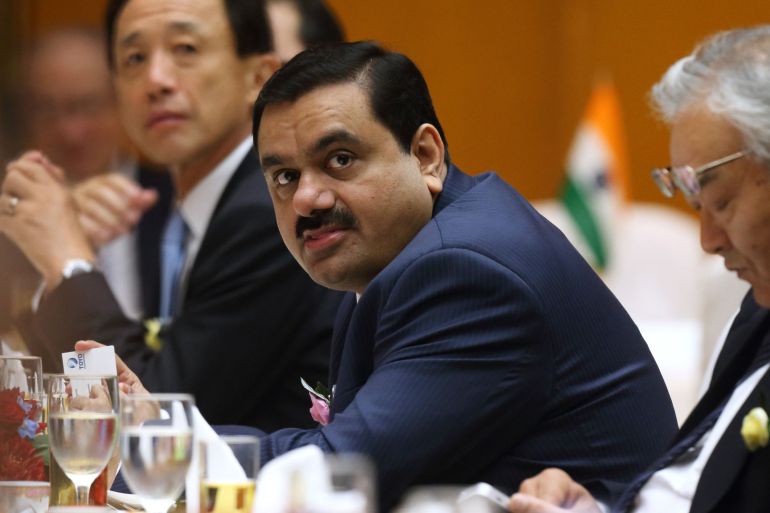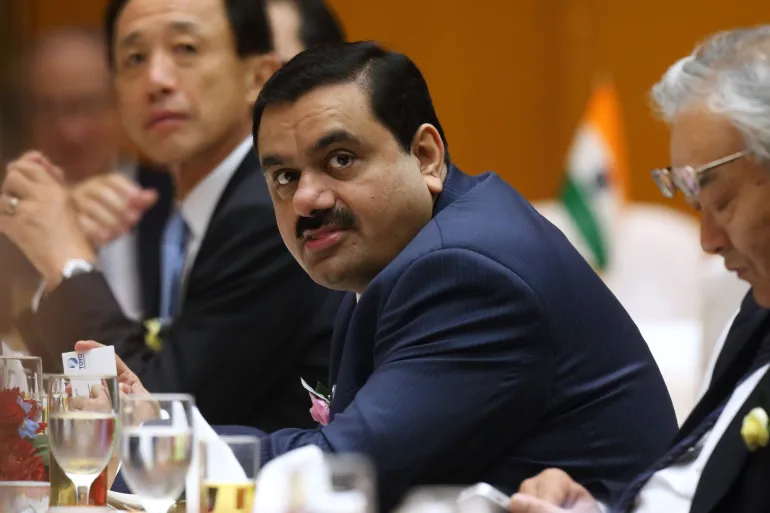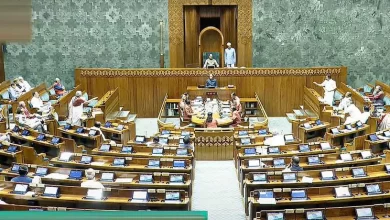Who is Gautam Adani and why is he controversial?
The Indian entrepreneur has seen his wealth plummet after a research firm accused him of ‘brazen stock manipulation’.

Allegations of stock market manipulation and fraud have halved the net worth of Indian tycoon Gautam Adani, one of the wealthiest people in the world, in less than two weeks and wiped more than $110bn from his listed firms in India.
With investor confidence shaken, legislators have demanded an investigation into his businesses. Here’s a look at who Adani is, what concerns have been raised and what has happened since.
Who is Gautam Adani?
He is the founder and chairman of the Adani Group, one of the largest business conglomerates in India. A native of Gujarat — the same state where India’s Prime Minister Narendra Modi is from — Adani, 60, is a college dropout. He walked away from his father’s textile shop to set up a commodities trading business in 1988, his entry into the world of business.
Forbes magazine ranked Adani as the third-richest person in the world. But a recent stock rout has caused his fortune to slip, as he faces allegations of stock manipulation and debt concerns by US-based short-seller Hindenburg Research.
What sectors does the Adani Group operate in?
The group has interests in ports, airports, gas distribution, green energy, data centres, agri logistics, edible oil, and power generation and transmission, among others. It reported revenues of $23bn in the most recent financial year, ending in March 2022.
The group is India’s biggest airport operator and also controls the Mundra Port in Adani’s home state, the country’s largest private port. Within this umbrella of businesses, seven firms are listed on the Indian stock exchanges. The Adani Group also owns a controversial coal mine in Australia, the Carmichael mine, which has been a lightning rod for climate change activists.
Over the years, the group has grown through acquisitions and collaborations. Most recently, in January, just days before the recent allegations, it led the consortium that bought Israel’s Haifa port. Last year, in June, French giant TotalEnergies SE and the Adani Group agreed to invest $5bn to produce green hydrogen and related products in India. In May, Adani became the second-largest cement producer in India after purchasing the Swiss firm Holcim’s India assets for $10.5bn.
Why is Adani’s rise controversial?
Adani’s rise has been meteoric and has benefitted from the support of Prime Minister Modi. Their ties date back to the days when Modi was the chief minister of Gujarat and Adani got land at cheap prices.
Claims of cronyism have followed Adani as he has picked up assets like ports, airport contracts and coal mines across the country, becoming one of the biggest and most powerful businessmen in the country in a very short span of time.
According to data from Forbes, Adani had a net worth of $2.8bn in 2014, just before the national elections that vaulted Modi into the role of prime minister. That wealth had catapulted to $126.4bn until the Hindenburg Research report on January 24 sent his business into crisis.
What is Hindenburg Research and what does its report say?
Hindenburg Research is a US-based forensic financial research firm that analyses the equity, credit and derivative offerings of companies. It looks for corporate wrongdoings and then places short-term bets against them.
Adani crisis ignites India contagion fears, credit warnings
The firm has alleged that the Adani Group has engaged in a “brazen stock manipulation and accounting fraud scheme over the course of decades”.
Hindenburg Research based its assessment on a two-year investigation during which it says it reviewed thousands of documents, conducted site visits in almost half a dozen countries, and spoke with dozens of individuals, including former senior executives of the Adani Group.
Here are some concerns the short seller has raised:
- Key listed Adani companies have “substantial debt”, and some have pledged shares of their stock for loans. Five of seven key listed companies have reported “current ratios” below 1, indicating near-term liquidity pressure.
- The Adani Group uses a web of firms in tax havens to inflate revenue and stock prices and also provide cushioning to capital balances in order to make listed entities appear more creditworthy.
- Offshore shells and funds tied to the Adani Group comprise many of the largest “public”, non-promoter holders of Adani stock.
- The group had “virtually non-existent financial controls” and listed Adani businesses have seen sustained turnover in the role of the chief financial officer (CFO) — including its flagship company, Adani Enterprises, which has had five CFOs over eight years, a red flag for accounting issues.
- The independent auditor for Adani Enterprises and Adani Total Gas is a tiny firm called Shah Dhandaria, which has no current website, four partners and 11 employees. The Hindenburg report said it “hardly seems capable of complex audit work”. The audit partners at Shah Dhandharia, who respectively signed off on the annual audits for Adani Enterprises and Adani Total Gas, were as young as 24 and 23 years old when they started. “They were essentially fresh out of school, hardly in a position to scrutinize and hold to account the financials of some of the largest companies in the country, run by one of its most powerful individuals,” the report said.
- The report alleged that Adani family members cooperated to create offshore shell entities in tax-haven jurisdictions like Mauritius, the United Arab Emirates and several Caribbean islands, generating forged import/export documentation in an apparent effort to spur fake or illegitimate turnover and siphon money from the listed companies. It also cited previous fraud investigations by the Indian government, which have alleged money laundering, theft of taxpayer funds and corruption, totalling an estimated $17bn.
What has Adani said about the allegations?
The Adani Group said the report was issued with a “mala fide [bad faith] intention” to damage its reputation, days before the group was set to hold a public secondary share sale to raise $2.5bn, the largest such sale in the country. The Adani Group has alleged that the report’s “principal objective” was to derail the share offer.
What has happened since the report came out?
Adani’s secondary share sale was fully subscribed, but in a shocking reversal, the group called it off, marking a stunning setback for founder Gautam Adani and sending his stocks plunging further. About $112bn have been shaved collectively off the group’s various listed firms so far, taking Adani’s personal wealth down as well.
While calling off the secondary share sale, Adani said the group will review its capital market strategy once the markets stabilise.
It is not clear when that will happen as the group’s stocks continue to nosedive. The stock market rout triggered a series of credit rating warnings from the agency Moody’s, which says that the group may struggle to raise capital. The market index S&P has also cut its credit outlook for two Adani Group companies, raising fears of contagion for the rest of the stock market.
In the meantime, legislators from India’s main opposition parties have kicked off protests at some state-run companies with ties to the Adani Group firms and have demanded an investigation into the group.
What next?
The Indian markets regulator is examining the crash in shares as well as probing for any irregularities in the $2.5bn share sale, the Reuters news agency has reported.
To calm investors’ nerves, the Adani Group on Monday made a prepayment of $1.11bn towards loans ahead of their maturity in 2024, releasing shares that had been pledged by the family as collateral. But it is too soon to say how far that step will go in assuaging investor concerns.
While Adani’s net worth has tanked more than half to $61.7bn in less than two weeks, he is still one of the most powerful people in the world, with vast businesses in key sectors in India, employing more than 23,000 people. It is unlikely that he will go away anytime soon.
SOURCE: AL JAZEERA




